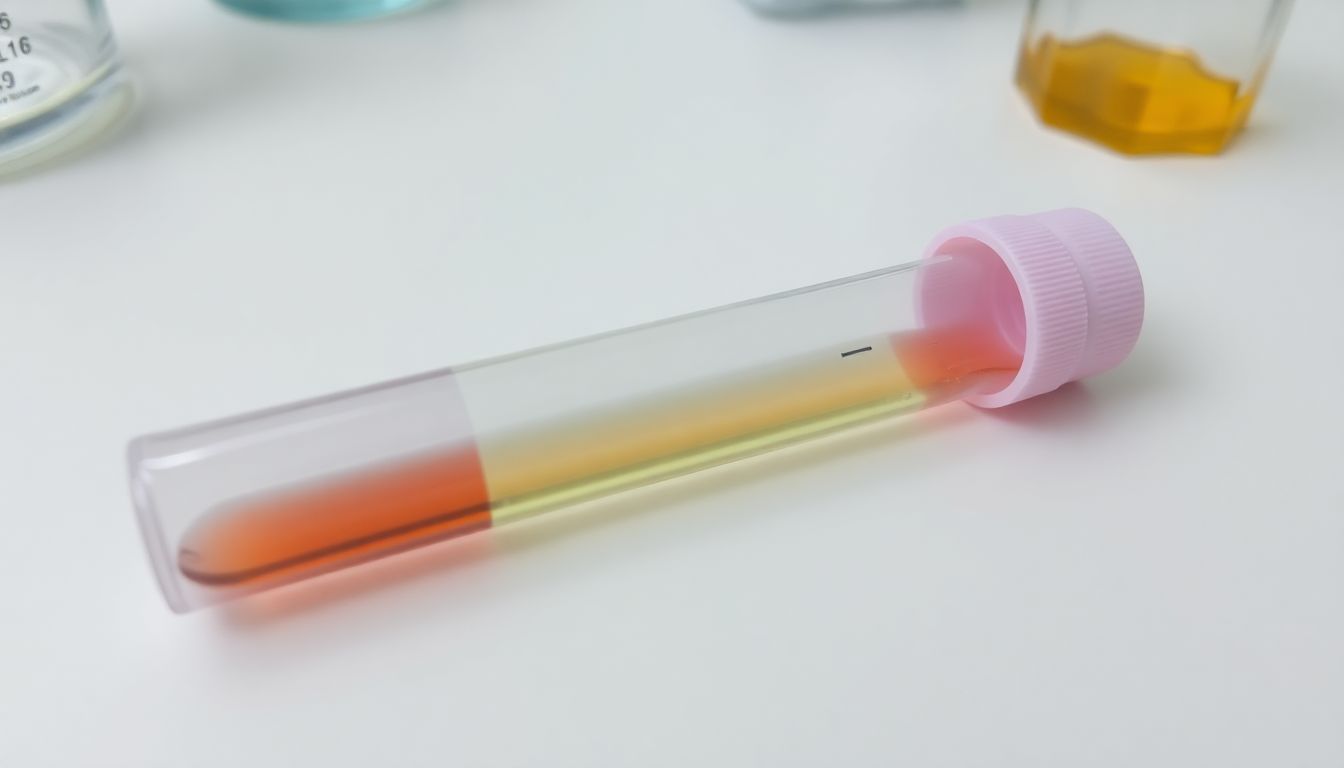Prostate cancer is a big concern for many men as they age. Traditional tests like PSA blood tests and rectal exams are not always accurate. A new urine test offers a safer, more precise way to detect prostate cancer early.
Thank you for reading this post, don't forget to subscribe!Keep reading to learn how this breakthrough can help protect your health.
Key Takeaways
- A new urine test, like MyProstateScore (MPS), can detect aggressive prostate cancer with more accuracy than PSA tests and rectal exams.
- The test reduces unnecessary biopsies by identifying biomarkers linked to high-grade tumors while avoiding low-risk cases.
- It is non-invasive, painless, and improves early detection for better treatment outcomes.
- Researchers like Arul M. Chinnaiyan and institutions such as the National Cancer Institute helped develop this innovative method using RNA sequencing.
- Early detection through this test may increase survival rates and improve quality of life for men worldwide.
The New Urine Test for Prostate Cancer Diagnosis
A new urine test can detect prostate cancer with higher accuracy. This method offers a simple and painless way to help diagnose the disease early.
More precise results
Urine tests like MyProstateScore (MPS) offer more precise results than older methods. They detect biomarkers, improving accuracy in spotting clinically significant prostate cancer.
These tests reduce errors seen with elevated PSA levels that can come from benign conditions.
This approach focuses on high-grade tumors needing treatment. It avoids over-diagnosing low-grade prostate cancers. Fewer false alarms mean better cancer diagnosis and fewer unnecessary biopsies for men.
Non-invasive alternative to biopsies
Biopsies involve needles and discomfort, making them a stressful process for many men. This new urine test changes everything by offering a non-invasive option. It analyzes biomarkers in urine to detect clinically significant prostate cancer without the need for tissue samples from a prostate biopsy.
Unnecessary biopsies are reduced dramatically with this method. The test identifies aggressive prostate cancers while sparing low-grade cases or benign conditions from invasive procedures.
With tools like MyProstateScore (MPS) and advancements like RNA sequencing, it’s now easier to check for high-grade tumors through simple screening tests.
Traditional Methods for Prostate Cancer Diagnosis
Prostate cancer screening has relied on familiar methods for years. These include tests that check the prostate gland and blood for signs of trouble.
Digital rectal exams (DRE)
Doctors often use digital rectal exams (DRE) to check for prostate cancer. During the exam, a doctor feels the prostate gland through the rectum to find lumps or hard areas. It’s quick but can be uncomfortable for patients.
Results from DREs may sometimes be unclear. This means doctors might need other tests like PSA screening or biopsies to confirm findings. New methods aim to improve accuracy and make procedures less invasive—leading into urine testing advancements.
Prostate-specific antigen (PSA) tests
Prostate-specific antigen (PSA) tests measure a protein made by prostate cells. Elevated PSA levels can suggest prostate cancer, but not always. Other factors like enlarged prostates or infections may also cause high readings.
Results from PSA tests are often unclear and may lead to unnecessary biopsies. While they help detect clinically significant prostate cancer, these tests sometimes miss aggressive forms or overdiagnose low-grade tumors.
Transitioning to more precise methods brings hope for better screening options—like the innovative urine test in development.

Benefits of the Urine Test
The urine test helps detect prostate cancer more accurately. It also lowers the need for painful procedures like biopsies.
Reducing unnecessary biopsies
Biopsies can be stressful and invasive. Many men, especially those with low-grade prostate cancer, undergo them without need. Unnecessary biopsies may lead to pain, anxiety, or infections.
The new urine test gives clearer answers. It checks for biomarkers like RNA sequencing linked to high-grade tumors. This helps doctors focus on clinically significant cases while avoiding needless procedures.
Elevated PSA levels no longer guarantee a biopsy—this test narrows it down better than before.
Enhancing accuracy of cancer detection
Urine tests, like MyProstateScore (MPS), improve prostate cancer detection. These biomarker tests identify RNA linked to high-grade tumors. Unlike PSA tests, which often lead to unnecessary biopsies due to elevated PSA levels, MPS focuses on clinically significant prostate cancers.
Advanced methods such as RNA sequencing highlight tumor-specific genes in urine samples. This boosts the accuracy of spotting cancer early. The National Cancer Institute and researchers like Arul M.
Chinnaiyan have been key in refining these techniques for precise results.
Importance of Early Detection
Catching prostate cancer early can make treatment more effective. It helps prevent the disease from spreading to other parts of the body.
Improving treatment outcomes
Early detection of prostate cancer helps improve treatment success. The new urine test identifies clinically significant prostate cancer earlier than traditional methods. Detecting high-grade tumors sooner allows doctors to act quickly, stopping them before they spread to other parts of the body.
This test reduces unnecessary biopsies and provides precise results. Better diagnosis means patients with low-grade prostate cancer can stay under active surveillance instead of facing invasive procedures.
Early intervention lowers risks, increases survival rates, and improves quality of life for many men worldwide.
Higher patient compliance
Non-invasive tests like the urine test reduce fear and discomfort. Patients often avoid prostate biopsies due to pain or invasive procedures, but urine tests offer a stress-free option.
Higher compliance means more men will undergo cancer screening earlier. Detecting high-grade tumors sooner improves survival rates and reduces risks tied to delayed diagnosis.
The next section explains how collaboration helped develop this innovative test.
Collaboration in Developing the Urine Test
Researchers, doctors, and diagnostic companies worked together to create the urine test. Their joint efforts combined advanced science with medical know-how to improve prostate cancer diagnosis.
Involvement of researchers, medical professionals, and diagnostic companies
Experts from various fields worked together to create the urine test for prostate cancer. Researchers used RNA sequencing and studied prostate tissue to find biomarkers linked to aggressive prostate cancer.
Institutions like the University of Michigan, Howard Hughes Medical Institute, and National Cancer Institute (NCI) supported this work.
Medical professionals helped by testing methods like MyProstateScore (MPS) on patients with elevated PSA levels. Diagnostic companies refined these tools into accurate tests for clinically significant prostate cancer.
Their teamwork aims to reduce unnecessary biopsies and improve early detection through better cancer screening options.
Emphasis on Ongoing Research
Researchers are working hard to improve prostate cancer tests and treatments—promising better tools for early detection and care in the future.
Advancements in prostate cancer diagnosis and treatment innovations
Doctors now use advanced tests like the MyProstateScore (MPS) and its improved version, MyProstateScore 2.0 (MPS2). These biomarker tests help detect aggressive prostate cancer with higher accuracy.
Scientists have also used RNA sequencing to study prostate tissue, finding key genes linked to high-grade tumors.
Magnetic resonance imaging (MRI) has grown in importance too. It creates clear images of prostate volume and tumor cells without the need for invasive procedures. Research funded by groups like the National Cancer Institute and Prostate Cancer Foundation continues to explore new ways to improve early detection and reduce unnecessary biopsies.
Conclusion
Early detection saves lives, and this urine test offers hope. It provides precise results without the need for invasive biopsies. More men may now feel comfortable with screening for prostate cancer.
Continued research will only make tools like this even better. Prostate health is a priority worth investing in.
